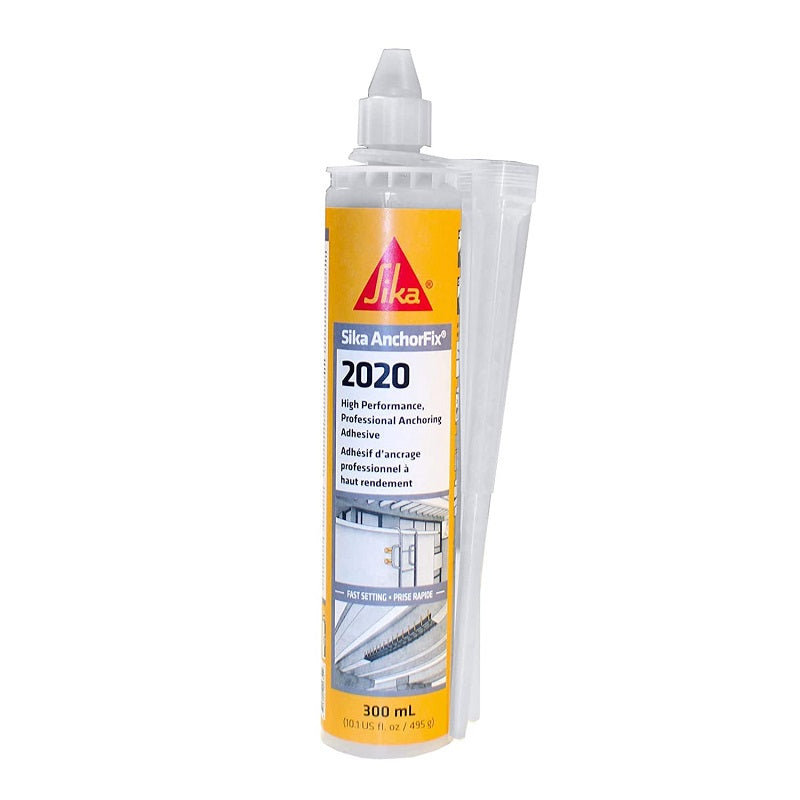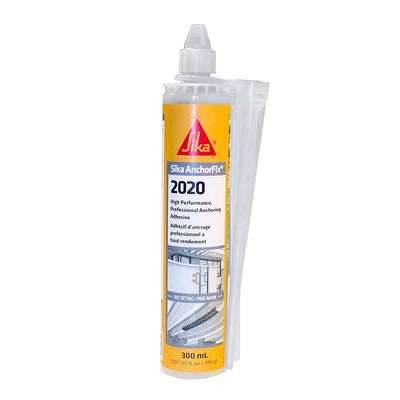HIGH PERFORMANCE, PROFESSIONNAL GRADE EPOXY ACRYLATE ANCHORING ADHESIVE
Description
Description
Sika AnchorFix®-2020 is a two-component, solvent and styrene-free, epoxy acrylate-based anchoring adhesive engineered for application down to -10 °C (14 °F). Sika AnchorFix®-2020 achieves high early strengths quickly in numerous base materials and is suitable for medium / heavy loads in both structural and non-structural applications.
Where to Use
- Anchoring of all grades of rebars / threaded rods in concrete, masonry, voided stone and rock, hard natural stone and solid or hollow bricks and blocks.
- Grouting horizontally and vertically, where extremely rapid setting, fast turn-around times are needed.
- Suitable for cooler temperatures and inclement conditions, including -10 °C (14 °F) temperatures and wet substrates.
- Grouting in external environments where applications are subject to dynamic loads and vibrations.
- Use as a ‘pick-proof’ sealant in secure or holding suites and similar facilities.
- Anchoring structural steel to concrete, safety barriers, balcony stanchions, canopies, signs, hand rails, racking, machinery, masonry supports, stadium seats, reinforcing and starter bars.
- Fast curing - cures down to -10 °C (14 °F) when material is pre-conditioned to 5 °C (41 °F).
- Cartridge format compatible with standard application guns.
- High load capacity.
- Suitable for cracked and uncracked concrete.
- Styrene-free, VOC-compliant and odourless.
- Non-sag, may be applied overhead.
- Sets up in dry or damp holes.
- Approved for threaded rods and reinforcing bars in concrete.
- Approved for threaded bars and sockets in masonry.
- Reduced edge and spacing values allowing critical applications.
- Reduced drilling diameters of 2 mm clearance resulting in economic installation.
- Flexible embedment depths from 8d -12d.
- Resistant to a wide range of chemicals. Contact Sika Canada for detailed information.
- Design guide and software available. Contact Sika Canada for technical support.
- ANSI/NSF Standard 61 approved for contact with potable water.
- Seismic Design Categories: C, D, E & F under the IBC or IRC.
- ES to AC308 by IAPMO (ER-0601) - approved for cracked and uncracked concrete.
- Product qualified by The Road Authority (TRA) and approved by the Ministry of Transportation of Ontario (MTO) - 9.30.25 prequalification list for Structural Dowel Adhesives - Acrylic and Epoxy Resins.
- Ministère des Transports du Québec approved
- IBC/IRC
| Packaging |
300 mL (10.1 US fl. oz) single piston cartridges/12 per case 825 mL (27.8 US fl. oz) side-by-side 10:1 cartridges/6 per case |
|
Colour |
Component A: white,
Component B: black
Component A+B mixed: grey |
| Shelf Life |
12 months if stored properly in original and unopened packaging, in cool and dry conditions, out of direct sunlight, and at temperatures between 5 and 25 °C (41 and 77 °F). Pre-condition product to 23 °C (73 °F) to ease application when using hand dispensers and working at low temperatures. |
|
Mix Ratio A:B |
10:1 by volume |
| Service Temperatures |
-40 °C min. / +50 °C max. (-40 °F min. / 122 °F max.) |
Application Temperatures
| Application Temperatures |
Set Time* |
Curing Time |
|
35 °C (95 °F) |
2 min |
30 min |
|
25 - 30 °C (77 - 86 °F) |
4 min |
40 min |
|
20 - 25 °C ( 68 - 77 °F) |
5 min |
50 min |
|
10 - 20 °C (50 - 68 °F) |
6 min |
1 h 25 min |
|
5 - 10 °C (41 - 50 °F) |
10 min |
2 h 25 min |
|
0 °C (32 °F)* |
18 min |
3 h 30 min |
| - 10 °C (14 °F)* |
50 min |
12 h |
*Cartridge / adhesive maintained at 5 °C (41 °F) minimum.
Properties at 20 °C (68 °F) and 50 % R.H.
Chemical Resistance Consult Sika Canada
Product properties are typically averages, obtained under laboratory conditions. Reasonable variations can be expected on-site due to local factors, including environment, preparation, application, curing and test methods.
HOW TO USE
Surface Preparation
Surfaces must be clean and sound. Surfaces / holes may be dry, damp or wet. Remove dust, laitance, grease, oil, curing compounds, impregnations, waxes, foreign particles and disintegrated materials. Substrate strengths must be verified, with pull-out tests being conducted if strength is unknown.
| Compressive Strength ASTM D695 | |
|
24 hours 7 days |
73 MPa (10 600 psi) 78 MPa (11 300 psi) |
| Tensile Strength ASTM D638 |
|
| 24 hours 7 days |
12 MPa (1740 psi) 14 MPa (2036 psi) |
| Elongation at Break ASTM D638 |
|
| 24 hours 7 days |
6.2 % 7.1 % |
| Tensile modulus ASTM D638 |
|
| 24 hours 7 days |
3.7 GPa (542 000 psi) 3.8 GPa (554 000 psi) |
| Flexural Strength ASTM D790 |
|
| 24 hours |
28 MPa (4060 psi) |
| Heat Deflection Temperature ASTM D648 |
|
| 7 days |
76 °C (169 °F) |
| VOC Content |
39 g/L |
Chemical Resistance Consult Sika Canada
Product properties are typically averages, obtained under laboratory conditions. Reasonable variations can be expected on-site due to local factors, including environment, preparation, application, curing and test methods.
HOW TO USE
Surface Preparation
Surfaces must be clean and sound. Surfaces / holes may be dry, damp or wet. Remove dust, laitance, grease, oil, curing compounds, impregnations, waxes, foreign particles and disintegrated materials. Substrate strengths must be verified, with pull-out tests being conducted if strength is unknown.
Application Solid Substrate Installation
- Drill the hole to the correct diameter and depth to suit the anchor, using a rotary percussion drill and carbide-tipped bit.
- Thoroughly clean the hole in the above sequence. Use an air lance inserted into the back of the hole with the trigger depressed for 2 seconds, blow out all debris. The compressed air must be free from oil and water with a minimum pressure of 6 bar (90 psi). If using a hand pump for holes of 400 mm (16 in) deep or less, pump twice to achieve clean holes. If the hole collects water after the initial cleaning this water must be removed before injecting the resin.
- Select an appropriate sized nylon brush, ensuring it is in good condition and suited to the diameter of the drilled hole. Insert the brush to the back of the hole and pull out using a back and forth rotating motion to remove all loose friable material. Repeat the brushing operation. Repeat the steps 2 and 3, finishing with step 2.
- Select the appropriate static mixer nozzle for the installation. Also, prepare a good quality dispensing gun, ensuring it is in good working order to extrude the anchoring gel. Wherever practical, use pneumatic dispensers for optimum ease of dispensing.
- Unscrew and remove the threaded cap. Pull out the exposed and wire tied plastic film and cut below location of tie.
- Screw the static mixer nozzle to the cartridge, secure with the integral nut and insert the assemblage into the dispensing gun. Trigger the dispenser until a uniform colour (no streaking) and consistency are achieved with unmixed material going to waste. If necessary, cut an extension tube to the depth of the hole and push onto the end of the static mixer, and (for rebars 16 mm (5/8 in) diameter or more) fit the correct resin stopper to the other end.
-
Insert the static mixer tip (resin stopper / extension tube if applicable) to the base of the hole. Begin to extrude the resin, under constant and uniform pressure, and slowly withdraw the static mixer from the hole. Fill the hole to approximately ½ to ¾ full and remove the static mixer completely.
Note: If dispensing is interrupted or altered, re-establish consistency of resin prior to continuing. When using a manual dispenser, release piston pressure by pressing thumb plate at every pause in extrusion. - Insert the threaded bar or reinforcing bar (both should be free from oil or other release agents) to the back of the hole using a back and forth rotating motion ensuring all the threads are thoroughly coated. Adjust to the correct position within the stated working time. Any excess resin should be expelled from the hole evenly around the steel element showing that the hole is full. This excess resin should be removed from around the opening to the hole before it sets.
- Leave the anchor undisturbed until the appropriate loading time has been achieved, which will be dependent upon the substrate conditions and ambient temperatures.
-
Attach the fixture and tighten the nut to the recommended torque, DO NOT OVERTIGHTEN.
Overhead applications: Overhead installation is limited to a maximum embedment depth of 10 x rod diameter. All other directions may be installed up to a maximum effective embedment depth of 12 x rod diameter. The use of wedges is not required for overhead installation. However, when temperatures exceed 21 °C (70 °F), it is advised to use wedges to fix anchors installed overhead until full cure time has elapsed as a precautionary measure
Hollow Substrate Installation
- Drill the hole. Then insert the brush using one stroke to clean followed by one blast of oil-free compressed air. Ensure that the drilled hole dimensions are suitable to accommodate a perforated sleeve of the appropriate length and diameter.
- Select the appropriate perforated sleeve and insert into the hole.
- Insert the static mixer to the back of the perforated sleeve, withdraw 2 - 3 mm (1/16 - 1/8 in) then begin to extrude the resin and slowly withdraw the static mixer from the hole ensuring that there are no air voids as it is withdrawn. Fill the perforated sleeve completely and remove the static mixer completely.
- Follow instructions for Solid Substrate Installation 8 – 10, ensuring that gel times and loading times are adhered to before attaching any fixtures and tightening to the recommended torque, where being employed.
Collect with absorbent material. Dispose of in accordance with local disposal regulations. Uncured material can be removed with Sika® Epoxy Cleaner. Cured material can only be removed mechanically.
Limitations
- Sika AnchorFix®-2020 is not intended as a cosmetic or decorative material and when anchoring into porous substrates or reconstituted stone, staining or decoloration may occur. Where this is of concern, it is recommended that Sika Canada be consulted for advice and discrete trial applications be undertaken and assessed before proceeding.
- Anchoring in solid rock and/or hard natural stone: The strength, composition and porosity of such substrates may greatly vary; it is always recommended to test the product in a sample area to evaluate bond strength.
- Store material to above 5 °C (41 °F) and, for ease of application by manual dispensers, precondition to higher temperatures, for example 23 °C (73 °F) when working at low temperatures; the higher the temperature the easier to dispense. Take into consideration reduced working times.
- Maximum thickness: 5 mm (6/32 in).
- Minimum age of concrete must be 28 days, depending on curing conditions.
- Do not thin; solvents will prevent proper cure.
- For overhead applications, read carefully the Application section.
- Standard and quality of dispenser will impact upon ease of extrusion, especially when using manual equipment; ensure the mechanical advantage is appropriate, pistons are correctly aligned and even pressure is achievable.
- Sika AnchorFix®-2020 must only be applied on or into substrates when they are frost-free.
For information and advice on the safe handling, storage and disposal of chemical products, users should refer to the most recent SAFETY DATA SHEET containing physical, ecological, toxicological and other safety-related data.
KEEP OUT OF REACH OF CHILDREN
FOR INDUSTRIAL USE ONLY
FOR INDUSTRIAL USE ONLY
DATA SHEET DOWNLOADS



